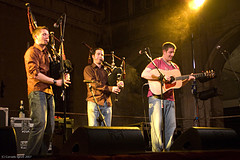The History of Celtic Jewelry
Jewelry has always been a way to signify status, and although wearing a lot of jewelry is considered too effeminate for modern men, ancient Celtic men did wear a significant amount. The type and materials of the jewelry they wore represented their rank and standing within the tribe. Celtic jewelry was known for its intricate designs based on continuous patterns.
The Celts were renowned for their skills in crafting jewelry, and at times, their work even surpassed the quality of jewelry made by the Byzantium people. It’s remarkable how these ancient people could create such sophisticated works of beauty with the crude tools they had at their disposal.
Celtic men used jewelry for both practical and decorative purposes. Brooches or pins were used to fasten their clothing, and they wore gold, silver, or bronze in their hair to keep it from falling into their faces. They also used amulets for good luck and wore charms around their necks or as bracelets. They sported buckles as well. Their jewelry was often richly decorated, crafted using ancient Celtic symbols to represent their individual personalities, social standing, or as protection against evil influences. The materials they crafted from included gold, silver, and bronze, with gold reserved for the most important or wealthiest individuals.
Celtic jewelry can be categorized into two periods: one dating back to ancient Celtic times and the other dating back to after their conversion to Christianity.
Mens Celtic Rings
Men also wore rings, similar to modern men wearing wedding rings today. However, it’s unclear if the ancient wedding rings featured Celtic knots and themes, which combine circles, squares, triangles, spirals, or crosses like we see today.
Celtic rings are some of the oldest forms of jewelry and carry a rich tradition. In ancient Celtic times, rings were considered the strongest symbol of marriage, conveying eternal love. They were also used to symbolize love for God and humanity. Celtic rings featured intricate woven designs, known as Celtic knots, with strands having no beginning or end. Celtic rings are believed to date back as far as the 1st century BC, partly due to the advent of the Bronze Age.
The Celtic Brooch or Cloak Pin
Both men and women used Celtic brooches or cloak pins to fasten their clothing, particularly their cloaks. The Celtic Tara brooch, housed in the National Museum of Ireland, is one of the most significant artifacts of ancient Celtic culture. Dating back to around 700 AD, it is a prime example of Christian-era Irish Insular art. The design and materials of the brooches would vary depending on the creator and wearer. The high-quality craftsmanship of the Tara brooch and the materials used (gold, silver, amber, and glass) suggest it was made for a high-ranking individual and used as a decorative item rather than for practical purposes.
Interestingly, many Celtic brooches or cloak pins from that time contained neither pagan nor Christian motifs in their design. Instead, they featured intricate abstract decorations known as Celtic knotwork and images of wolves’ heads and dragons’ faces.
Manuel Marino is a seasoned Senior Producer, Music Composer, and Artist with over a decade of experience. He specializes in branded entertainment across various mediums, including video games, films, and advertising campaigns. With 20+ years as a game music composer, Manuel has worked on numerous platforms, creating diverse orchestral soundtracks. HIRE ME


 Manuel is a passionate, driven, and techsavvy AV technician,
Manuel is a passionate, driven, and techsavvy AV technician, 
